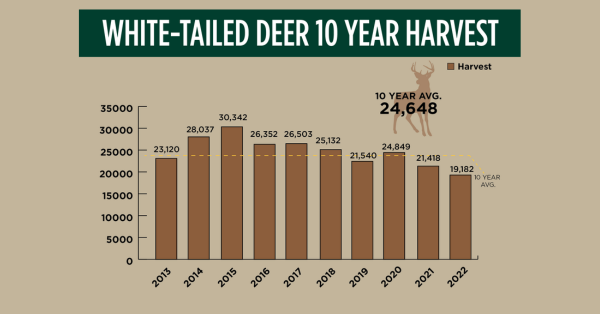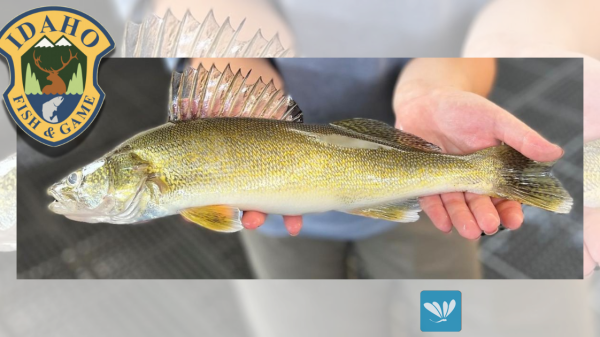White-tailed deer are among Idaho’s most productive big game animals
With early hunts starting and fall hunts fast approaching, thousands of Idaho hunters will be heading out to pursue Idaho’s big game animals, including white-tailed deer.
While there may always be some disagreement on how Idaho Fish and Game manages white-tailed deer, wildlife managers are listening to concerns from hunters about this important animal, and we all want what is best for the future of Idaho’s whitetails.
Is there cause for concern for Idaho’s white-tailed deer?
Overall, Idaho’s whitetails remain healthy and within historical population fluctuations, which include severe swings due to harsh winters, or disease outbreaks.
Statewide whitetail harvest peaked in 2015 with a state-record harvest of over 30,000 deer, and annual harvests have fluctuated between about 20,000 and 30,000 for most of the last decade. But there was a significant die-off of whitetails in portions of the Clearwater from epizootic hemorrhagic disease (EHD) in late summer 2021.
Fall whitetail harvest dipped that year, and the 2022 harvest was the lowest in more than a decade at just over 19,000 deer, due largely to an EHD die off in the Clearwater Region. Seeing the annual harvest drop by a third within eight years is concerning, but not unprecedented. For example, the 1995 whitetail harvest reached a then-record 28,500 deer, but dropped by nearly 50 percent within three years due to a severe winter, then later recovered.
Whitetails are among Idaho’s most productive big game animals, and when conditions are favorable, herds can reproduce at a faster rate than either mule deer or elk.

Recent history of whitetail disease and recovery
The 2021 die off also wasn’t the first time whitetail herds in north/central Idaho have been hit by EHD. After previous EHD-related die offs, white-tailed deer herds recovered within 5 years without additional restrictions on hunting opportunity.
However, after the 2021 die-off, the Fish and Game Commission cut 1,500 antlerless tags in the Clearwater Region to speed recovery. Although the Commission wasn’t due to change deer seasons until 2023, they made emergency changes in response.
White-tailed deer management in the Clearwater Region was also affected by the 2021 detection of chronic wasting disease (CWD) in Unit 14. The best way to minimize the spread of this deadly, uncurable, and contagious disease is to reduce deer densities where it’s found. People can learn more on the CWD webpage.
How Fish and Game monitors and manages white-tailed deer
Because of the densely vegetated habitats whitetails occupy, aerial surveys Fish and Game uses to estimate mule deer and elk populations in many parts of Idaho are usually ineffective or impractical for estimating whitetail populations.
Whitetails are primarily monitored through harvest data by wildlife managers in the U.S. and Canada. Fish and Game staff have used information from hunter harvest as an index to whitetail populations and distribution since 1975.
The harvest data Fish and Game collects and tracks over time includes harvest numbers, success rates, hunter days, gender of the animal, and antler points/age data.
Fish and Game biologists have also been working to develop and test new survey methods using remote cameras, which show promise for estimating numbers, composition (ratio of bucks, does, and fawns), and measuring buck quality. Once finalized, these methods will provide an additional tool for Fish and Game biologists to monitor many big game populations, including whitetails, in difficult-to-survey habitats.
Tracking buck harvests and buck quality data
Historically, the proportion of harvested bucks with more than four points on one antler was used as an index for buck age structure. However, biologists found the changes in the number of four-point bucks harvested didn’t always track changes in harvest, or season structure, so they shifted to monitoring the proportion of five-point bucks in the harvest as a more conservative indicator of age structure and antler quality.
Management objectives in the the 2020-2025 White-tailed Deer Management Plan specify goals for the proportion of harvested bucks meeting that five-point criteria: more than 10% for most of Idaho and more than 17% in the most productive areas of Idaho for whitetails (north Idaho forested and agriculture habitats). All portions of Idaho where white-tailed deer receive management priority over mule deer have exceeded these criteria since implementation of the management plan.
However, relevance of five-point minimum criteria has been questioned by some hunters, who suggest more restrictive management could increase availability of mature bucks. These hunters correctly point out that not all bucks with more than 5 points are large, mature animals they desire.
Management direction is guided by hunter input
Fish and Game’s whitetail management was shaped by public input. Idaho deer hunters have consistently told Fish and Game they want to hunt every year, and three-quarters of respondents to Fish and Game’s hunter survey that informed development of the 2020-2025 White-tailed Deer Management Plan said annual hunting opportunity was important to them.
Most whitetail hunters surveyed strongly valued opportunities to hunt in November (75%) and to hunt bucks every year (76%), and a majority (58%) were satisfied with their chances to harvest a mature buck.
When asked whether some hunting units should be managed for large white-tailed bucks, even if that meant shorter seasons or controlled hunts, more hunters opposed this concept than favored it, 42% vs 33%. However, the availability of mature bucks, and the opportunity to hunt them, remains important to white-tailed deer hunters.
Trading generous opportunity for restrictions in order to produce larger bucks
Some hunters have suggested the “Quality Deer Management” concept as a way to manage Idaho’s whitetail herds and habitat to produce more larger, mature bucks. QDM relies on intensive and selective harvest, particularly whitetail does, to reduce the overall deer density and provide more food for the remaining herds. QDM also requires fewer young bucks to be harvested annually so more bucks survive and have the chance to grow older and larger.
Implementing a similar management strategy in Idaho would mean less whitetail hunting opportunity, and more restrictions on the sex and age of deer that hunters could harvest. Essentially, hunters would be trading generous hunting opportunities for any buck to more restrictive opportunities with the potential for more larger bucks.
Hunters will continue to guide future management
Fish and Game understands that hunter sentiments may change, so biologists plan to check in with hunters in the future with a survey that will be used to update the White-tailed Deer Management Plan.
For more information on current white-tailed deer management direction in Idaho, review the 2020-2025 White-tailed Deer Management Plan on the Idaho Fish and Game website, watch for the next season-setting process in late 2024.

















